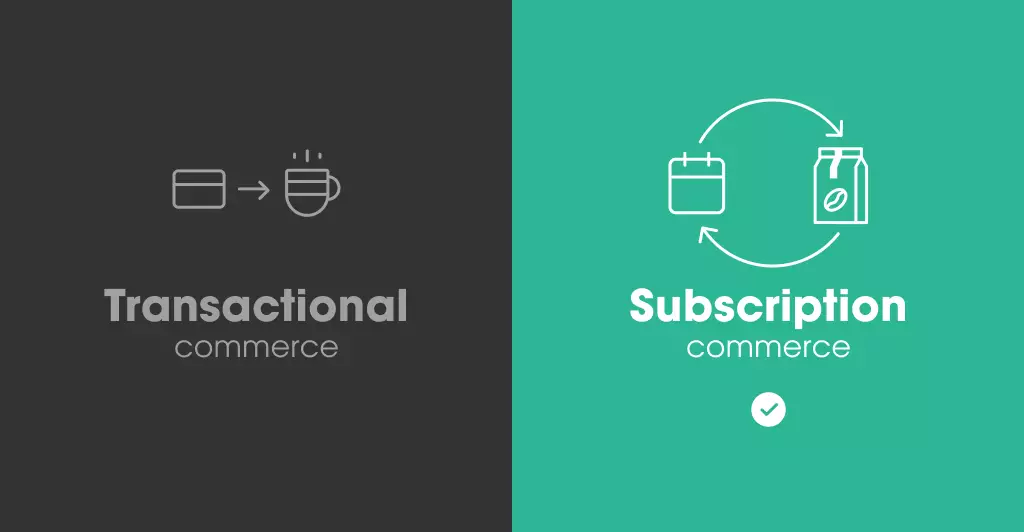
In some ways, subscription commerce is in opposition to transactional commerce (one-time sales). Prior to the subscription boom, transactional commerce was synonymous with e-commerce but since then, it’s been necessary to categorize subscription models separately from transactional ones.
At their extremes, these concepts are easy to spot: a business that only sells subscriptions is subscription commerce, and a business that sells one-time products is transactional. However, as commerce evolves, it’s increasingly common for companies to combine the two models together. Subbly is at the forefront of the subscription-first movement, and the conversation is getting much more nuanced.
What’s your priority?
Subscription commerce and transactional commerce are fully compatible; it isn’t about choosing one or the other anymore. The conversation has now shifted and it’s all about your priorities. For many businesses, the thought of intentionally setting priorities is foreign. These businesses are likely inadvertently prioritizing their transactional commerce – even if they sell subscriptions too. There are a few easy tells:
- The first thing your website visitors are directed toward is the typical “catalogue view” of one-time products.
- “Subscriptions” is an option buried in the top navigation or menu of your website.
- Customers have to dig through your website to find your subscription offering(s).
- Your subscription products are on a separate website, with a separate domain, and sometimes a different company name.
- Your subscription is a “crate” or “box” version of your primary business.
Of course, some businesses set their priorities intentionally and for them, the choice may be to err on the side of transactional. But many companies are still unknowingly straddling the line between transactional and subscription models, and by failing to choose a priority, they default to one-time products whether it’s good for their business or not. The primary reason: it’s the way it’s always been done. Businesses rely on website templates from an old, transactional era of commerce and use ecommerce platforms built for that time. The secondary reason: businesses want to offer customers all options, but they default to selling the products and services that require no customer commitment.
What is your default mode? Is it serving your business? If you value your subscription customers and revenue more than anything else, but you’re guilty of the five tells above, you may have your priorities backwards.
Subscription-first businesses can also sell one-time products
Just because you prioritize subscription, doesn’t mean you can’t sell one-time products too. In fact, some of the most successful subscription-first companies today are thriving in part because they integrate transactional commerce into their subscription business model, on top of following some general best practices.
Take dental hygiene startup Quip, for example. Customers have an option to try things out with a simple starter kit, including a handle, battery, toothbrush heads, and toothpaste. But once they run out of one of those things, they can set up a subscription, tailored to their use pattern, and make sure they never run out again. While it’s unlikely that a customer will need a new handle every month, people always need new brush heads every few months.
Spruce is another great example of a subscription-first company that gets people initially engaged through a starter kit, except in this case, it’s cleaning products. Customers can order a set of reusable bottles and a set of initial cleaning products, and then subscribe to monthly refills — the first month costing just £1 — which is a great way to get people stuck in if they like the quality.
Finally, take a look at the lessons we can learn from Nespresso, a household name in the coffee world. While they do sell one time products, subscription-first principles are deeply embedded in their business. First, they sell their coffee maker (transactional), but once that’s happened, Nespresso knows they have a long term customer who will be buying coffee pods for years.
From these three examples — and believe me, there are more — not only can you sell one-time products, but you can lead with them, upsell them, or put them anywhere along the customer journey. The subscription-first movement doesn’t demand that you choose one or the other, it’s just about your sales intent. Is your primary intention to sell a subscription? If so, create a customer experience that reflects that. If you want to sell subscriptions by default, you have to be intentional about it.
Why prioritize subscription?
As one Subbly customer puts it, “Done right, subscription customers are simply worth more.” And it’s true by the numbers. Indeed, data gathered by CaaStle, a subscription logistics provider, showed that one apparel brand reported that their rental subscribers spent 2.5x more on average than their traditional brand (non-subscription) consumers.
But it isn’t always about the money. Selling subscriptions reorients the business to an ongoing and long term relationship with your customer. Business owners who want long term subscribers place a greater deal of emphasis on customer experience, product quality, and adding value. Businesses who prioritize transactional commerce spend an outsized portion of their time on finding new customers.
Stop straddling and go all in
Admittedly, a subscription-first approach isn’t for everyone. Some products and businesses just aren’t well suited for it. But regardless, it’s worth it for every business to take a moment to be intentional. What do you prioritize and why? Some of you may find that by prioritizing transactional commerce, you’re missing out on what you value the most. The good news is, it’s never too late (and isn’t that hard) to reorient yourself toward that which will make you most successful and fulfilled as a business owner.
Subbly – the purpose built platform for starting and growing subscription businesses
